Frescoes in the kitchen: varieties, choices and examples

A beautiful, tastefully chosen fresco, if the overall design of the room and the style in which the pieces of furniture are made, can make the interior of the room original and unique. Many are happy to move away from standard solutions, but they do not even suspect that to transform the space, it is enough to turn to the ancient type of wall painting, which is very popular at the moment.

Decoration advantages
Fresco painting is a special trend in art. The creation of each piece takes a lot of time and effort, and requires high skill. The attractiveness of the frescoes is undeniable. The demand for these products and their popularity in the market is determined by such advantages as:
- high reliability, durability due to protection technology;
- the uniqueness of each actually created by hand "canvas";
- safety due to the use of natural pigments;
- application for any kind of interior;
- a wide selection of bases and textures;
- durability and brightness of the image;
- the ability to use in a large and small space.





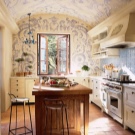
And also there is a huge selection of style solutions for the home due to the variety of themes.
Types of fresco painting
The traditional option is painting on wet plaster, on top of which a specific texture is applied. Then it is painted in the required tone, according to which the ornament or drawing is started. The advantages of this type:
- no need to level the surface;
- the painting can be washed;
- if necessary, there is the possibility of correction and restoration.
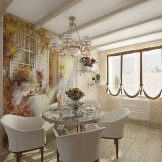
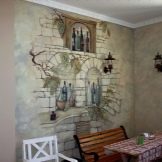


But the main plus is that the execution provides for an individual order, which means that no one will have such a second decoration. The disadvantages are a certain complexity of the workflow, special tools are needed. And also this type of painting is quite expensive.
In addition, in the kitchen, frescoes can be performed on different bases.
- Using linen or cotton as canvas. Additionally, sand, lime, natural pigments and glue are used. Taken together, a durable product is obtained that is reliably protected from moisture and the destructive effect of sunlight. The cost of such works is several tens of thousands of rubles per square meter, since the fresco is done by hand.

- The drawing can be done on a soft and elastic solution invented by Italian craftsmen. To prevent cracks, first a reinforcing mesh is fixed to the plaster, and natural dyes are applied using a method similar to the manufacture of printed products using a digital device. At the end, the artist finishes the image by hand. The decoration is fixed to the wall by means of glue.


- Non-woven is a more affordable base. Plaster is laid on a non-woven fabric with a layer of 2 mm, then painting is done using color photo printing. To protect the image from negative influences in the kitchen, the picture is impregnated with protective compounds. If desired, the fresco can be given an older look. Fastening type - non-woven wallpaper glue.
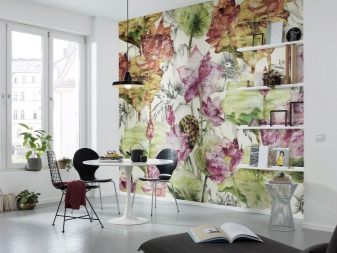

- There is also such a type of fresco painting as solid wallpaper. The product is distinguished by its significant weight, but small dimensions. In this case, manual labor is also present. The base is wood or ceramics - a solution is applied to it, and the image is transferred from above. The fresco is of particular value due to its aged appearance, for which the punctures are made in certain places. You can fix the painting with glue, or you can hang it like a painting.
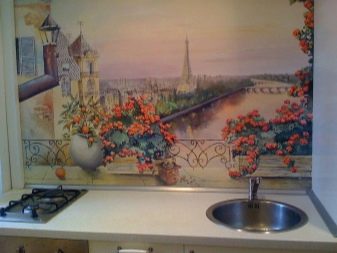

In addition, self-adhesive murals on a non-woven base can be seen on sale, but perfect wall alignment is required to place such products. Paintings are also made on glass surfaces attached on vertical planes using a special glue Affresco.
The most inexpensive option is wall murals. Despite the availability, this type of frescoes, although it looks good, does not possess the properties of a real product, therefore, it is susceptible to any unfavorable external conditions.
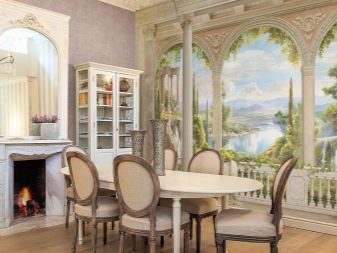

How to choose?
The most popular for decorating a kitchen is a classic still life, which contains elements such as fruits, flowers, sweets, and graceful bottles of wine. But in fact, you can choose from a wide range of these products. Thematically, the image may look like:
- reproductions of paintings by famous artists;
- lyrical and geometric abstractions, far from real forms and objects;
- patterns and ornaments from flowers;
- drawings imitating open veranda doors, balconies, open windows opening panoramic views;
- plots made in antique style, which are most suitable for the classic type of fresco - painting on plaster.



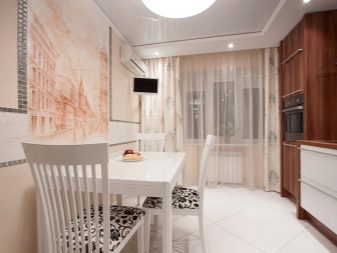
Forest, sea and mountain landscapes, cozy images of the city with narrow streets planted with flowers, large-scale views of the city with skyscrapers from above are in certain demand. The peculiarity of such images is that they visually expand the space and look harmonious in the interior.
Interesting design ideas
A fresco in the kitchen should reflect and emphasize the already chosen appearance of the room, and in this sense, the use of wall painting is very diverse. If a classic style is chosen for the kitchen, it can delight the owners for a long time, since this trend always remains popular, practically without going out of fashion. Images that mimic the following will help to complement the interior:
- the pomp of ancient ruins;

- romantic scenes in the Renaissance style;

- panoramic views of the city;

- historical sights;

- nature that creates a special feeling of comfort.

But you can also choose products that convey the luxury and grandeur, characteristic of the court of the French kings. Baroque frescoes are distinguished by a combination of gold and white tones, special luxury and majesty, especially in the frame of stucco moldings and decorative strips.
For those who prefer a warmer look for a room in which some housewives like to spend a lot of time with their family, including breakfast, lunch and dinner, you can recommend other types of fresco paintings.
- For lovers Provence style, creating a special home comfort, the interior can be supplemented with still lifes, frescoes depicting the coast of the sea, houses with brick walls entwined with grapes and ivy.

- Kitchens in country style it is customary to decorate with rural landscapes, floral patterns and still lifes with flowers, images of fields, gardens and cozy courtyards.

- You can decorate the kitchen in an elegant oriental styleby placing paintings on the walls in the form of marvelous floral ornaments.

- An original image can be obtained if you arrange a room in Mediterranean style... To do this, it is worth placing on the walls images of exotic flowers, plants and fruits, typical of this region. Landscapes with views of the mountains and the sea coast will also look great.

In the kitchen, frescoes can occupy both the entire wall and part of it. If the ceiling is low, it is better to place vertical images that visually make it taller. When decorating the kitchen, it is not necessary to use murals only for the walls. Sometimes existing niches and protrusions can be played up in an original way. They can be given the appearance of open balcony doors, behind which a wonderful panoramic view of a medieval castle, surrounded by picturesque mountains and green forests, or a sunny beach, immersed in the rays of the rising sun, opens.

If the kitchen is small, designers recommend placing small paintings on it in the form of still lifes., which do not distract much attention, but make the room cozier. Such drawings can be placed anywhere, for example, over a stove or even a sink, since they are made using special technologies and will not be affected by temperature and humidity. Frescoes depicting Mediterranean landscapes can also be an ideal decoration for small-sized kitchens. Such an addition can be inserted into a free wall, while the room will look elegant and stylish.

It is always possible to create a voluminous painting in accordance with the general style on the walls, which are not adjacent to the functional part of the kitchen, since there is usually a dining table in this area, and therefore the fresco in this place is especially relevant.
If you wish, you can decorate your kitchen with any thematic decoration - the main thing is that it does not look alien against the background of the interior and harmoniously fit into the overall design. Of course, it is also important how durable such an image will be, so it is worth thinking not only about the beauty of the painting, but also about its quality.

For information on how to choose frescoes for the kitchen, see the next video.








